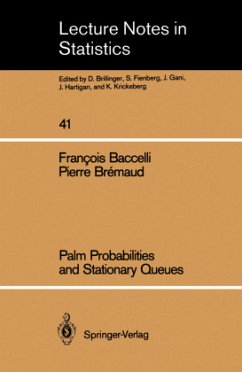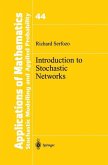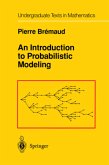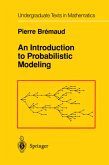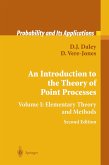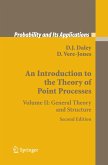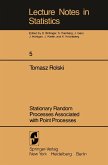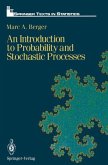Tables of Contents.- 1. Stationary point processes and Palm probabilities.- 1. Stationary marked point processes.- 1.1. The canonical space of point processes on IR.- 1.2. Stationary point processes.- 1.3. Stationary marked point processes.- 1.4. Two properties of stationary point processes.- 2. Intensity.- 2.1. Intensity of a stationary point process.- 2.2. Intensity measure of a stationary marked point process.- 3. Palm probability.- 3.1. Mecke¿ s definition.- 3.2. Invariance of the Palm probability.- 3.3. Campbell¿ s formula.- 3.4. The exchange formula (or cycle formula) and Wald¿ s equality.- 4. From Palm probability to stationary probability.- 4.1. The inversion formula.- 4.2. Feller¿ s paradox.- 4.3. The mean value formulae.- 4.4. The inverse construction.- 5. Examples.- 5.1. Palm probability of a superposition of independent point processes.- 5.2. Palm probability associated with selected marks.- 5.3. Palm probability of selected transitions of a Markov chain.- 6. Local aspects of Palm probability.- 6.1. Korolyuk and Dobrushin¿ s infinitesimal estimates.- 6.2. Conditioning at a point.- 7. Characterization of Poisson processes.- 7.1. Predictable ?-fields.- 7.2. Stochastic intensity and Radon-Nikodym derivatives.- 7.3. Palm view at Watanabe¿ s characterization theorem.- 8. Ergodicity of point processes.- 8.1. Invariant events.- 8.2. Ergodicity under the stationary probability and its Palm probability.- 8.3. The cross ergodic theorem.- References for Part 1: Palm probabilities.- 2. Stationary queueuing systems.- 1. The G/G/1/? queue : construction of the customer stationary state.- 1.1. Loynes¿ problem.- 1.2. Existence of a finite stationary load.- 1.3. Uniqueness of the stationary load.- 1.4. Construction points.- 1.5. Initial workload and long term behaviour.- 2. Formulae for the G/G/1/? queue.- 2.1. Construction of the time-stationary workload.- 2.2. Little¿ s formulae: the FIFO case.- 2.3. Probability of emptiness.- 2.4. Takacs formulae.- 3. The G/G/s/? queue.- 3.1. The ordered workload vector.- 3.2. Existence of a finite stationary workload vector.- 3.3. Construction points.- 3.4. The busy cycle formulae.- 4. The G/G/1/0 queue.- 4.1. Definition and examples.- 4.2. Construction of an enriched probability space.- 4.3. Construction of a stationary solution.- 5. Other queueing systems.- 5.1. The G/G/? pure delay system.- 5.2. The G/G/1/? queue in random environment.- 5.3. Priorities in G/G/1/? : the vector of residual service times.- 5.4. Optimality properties of the SPRT rule.- 6. The Bedienungssysteme.- 6.1. The mechanism and the input.- 6.2. A heuristic description of the dynamics.- 6.3. The initial generalized state.- 6.4. The evolution.- 6.5. Examples.- 7. The insensitivity balance equations.- 7.1. Stability and regularity assumptions.- 7.2. Insensitivity balance equations.- 7.3. Examples.- 7.4. Assumption on the input.- 7.5. Two immediate consequences of the insensitivity balance equations.- 8. The insensitivity theorem.- 8.1. The Palm version.- 8.2. From Palm to stationary.- 8.3. The stationary version and Matthes product form.- 9. Insensitivity balance equations are necessary for insensitivity.- 9.1. The converse theorem.- 9.2. The method of stages.- 9.3. Proof of the converse theorem.- 9.4. Example.- 10. Poisson streams.- 10.1. Privileged transitions.- 10.2. Sufficient conditions for Poissonian streams.- 1. Change of scale.- 2. Proof of insensitivity.- 3. The transition marks.- 4. Proof of (8.3.5).- 5. Proof of (9.1.3).- 6. Proof of the converse theorem in the general case.- References for part 2: Stationary queueing systems.
Hinweis: Dieser Artikel kann nur an eine deutsche Lieferadresse ausgeliefert werden.
Hinweis: Dieser Artikel kann nur an eine deutsche Lieferadresse ausgeliefert werden.

